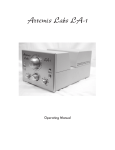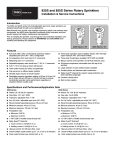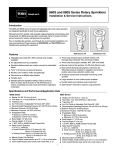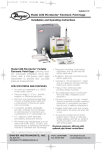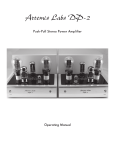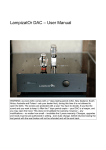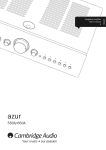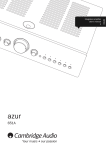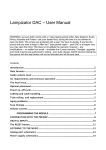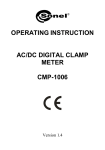Download Artemis Labs PH-1 User Manual
Transcript
Artemis Labs PH-1 Phono Preamp for High-Output Cartidges Operating Manual Important Safety Instructions 1. Read these instructions. 2. Keep these instructions. 3. Heed all warnings. 4. Follow all instructions. 5. Do not use this apparatus near water. 6. Clean only with a dry cloth. 7. Do not block any ventilation openings. Install in accordance with the manufacturer’s instructions. 8. Do not install near any heat sources such as radiators, heat registers, stoves, or other apparatus (including amplifiers). 9. Do not defeat the safety purpose of the grounding-type plug. A grounding-type plug has two blades and a third grounding prong. The third prong is provided for your safety. If the provided plug does not fit into your outlet, consult an electrician for replacement of the obsolete outlet. 10. Protect the power cord from being walked on or pinched particularly at plugs, convenience receptacles, and the point where they exit from the apparatus. 11. Only use attachments/accessories specified by the manufacturer. 12. Unplug this apparatus during lightning storms or when unused for long periods of time. 13. Refer all servicing to qualified service personnel. Servicing is required when the apparatus has been damaged in any way, such as if the power-supply cord or plug is damaged, liquid has been spilled inside the appliance or it has been exposed to moisture, the appliance does not operate normally, or has been dropped. 14. WARNING: To reduce the risk of fire or electric shock, do not expose this apparatus to rain or moisture. Explanation of Safety Symbols: CAUTION ATTENTION RISK OF ELECTRIC SHOCK DO NOT OPEN RISQUE DE CHOC ELECTRIQUE NE PAS OUVRIR CAUTION: To reduce the risk of electric shock, do not remove the covers. No user-serviceable parts inside. Refer Servicing to qualified service personnel. This symbol is intended to alert the user to the presence of uninsulated “dangerous voltage” within the product’s enclosure that may be of sufficient magnitude to constitute a risk of electric shock to persons. This symbol is intended to alert the user to the presence of important operating and maintenance (servicing) instruction in the literature accompanying the appliance. Page 2 INTRODUCTION & SPECIFICATIONS The Artemis Labs PH-1 Phono preamplifier is specifically designed for medium- to high-output phono cartridges. It combines the clean, accurate sound of a purist phono preamplifier with the convenience and reliability of a solid, well-built product. Special care is taken with all parts in the audio path. All aspects of the design were done by John Atwood of One Electron™. The PH-1 is conservatively designed and is built to last for many years. The only maintenance needed is the occasional replacement of tubes, and even this has been reduced by the use of Cool-Swap™ technology. Please read this entire user’s manual so that you can understand all the features and get the most from the PH-1. The Warranty is on a separate card. Read it and send it in to get full warranty coverage. SPECIFICATIONS: Mid-Band Gain (47K load, 1KHz): 52dB +/– 2dB Frequency Response & Distortion (measured with inverse RIAA curve applied to generator): Worst-case Loading (12K ohms, 1000pF): Frequency Response: 25Hz – 30KHz +/– 0.5dB THD+N at 1KHz, 2Vrms output: < 0.2% Average Loading (47K ohms, 250pF): Frequency Response: < 10Hz – 42KHz +/– 0.5dB THD+N at 1KHz, 2Vrms output: < 0.2% Maximum output voltage (47K load, 1KHz, 0.5% THD): 40Vrms Output Noise (grounded input, 47K load, rms detector): 22Hz - 30KHz: < –59dB below 2Vrms output “A-weighted”: < –69dB below 2Vrms output Crosstalk: 1KHz: < –TBDdB 20KHz: < –TBDdB Effective Output Impedance: approx. 1300 ohms (1KHz) Input Impedance: 47.5K ohms, lower with optional shunt resistors. Mains Voltage: Wired at factory for one of the following voltages: 100, 110, 120, 220, 230, 240V, 50 to 60Hz. Power Consumption (rms) : 40 Watts nominal, 49 Watts maximum. Size: 6 ½" (165 mm) Height, 8 ½" (216 mm) Width, 14 5⁄ 8 " (371 mm) Depth Mass: 24 lbs. (11Kg) Note: These specifications are subject to change at any time. Page 3 FRONT & REAR PANEL FRONT PANEL The Power Switch applies power when flipped up. The Power Indicator will glow red while the tubes warm up, then after approximately 40 seconds, will glow green. About 4 second after that a faint click will be heard, indicating the muting relay turning off. The PH-1 is now ready for use. If the power is removed, even briefly, then restored, the warm-up time delay process will start over again. REAR PANEL Voltage Rating Fuse IEC Power Connector Ground Terminal Right Input Right Outputs Left Input Left Outputs Input Cover Outputs 1 and 2 Make sure that the Voltage Rating of your PH-1 matches the power mains voltage at your location. The voltage can be changed by internal rewiring, which can be done by Artemis Labs or by a qualified technician. The Fuse is a 1" x 1¼" “3AG” Slow-blow type. Its value is given on the Voltage Rating sticker. A power cord is supplied with each unit. If the mains plug does not match your socket, contact your dealer to exchange it for the correct type. The power cord plugs into the IEC Power Connector. If the power cord is frayed or damaged, replace it with a new one. Use only power cords that meet the safety standards of your location. The Ground Terminal is used to connect the chassis of the PH-1 to the turntable and other equipment in your system to help minimize hum and noise. Experiment with different connections for the best results. The phono cartridge connects to the preamp through the Right and Left Inputs. There are two pairs of outputs: Outputs 1 and 2. These are essentially in parallel, separated by low-value resistors. This allows the preamp outputs to drive another device in addition to the line amp or power amp. The Input Cover is attached by three thumb screws. A Philips screwdriver may be needed to loosen the screws if they are tight. Under the cover are the two bias batteries and the ZIF socket that holds the optional input load Page 4 REAR PANEL resistors. It is recommended that the phono inputs be disconnected when the input cover is removed. The Bias Batteries supply a fixed grid bias to the 6N1P input tube. No current is drawn from them, so the batteries will last as long as their “shelf-life”, typically five years or more. Replace the batteries if they measure 1.4 volts or less. Symptoms of weak batteries are distortion and the 6N1P running hotter than normal. Replace only with type “N” or “AM-5” 1.5 volt alkaline batteries. Make sure that the batteries are installed with the + end (with the bump) upwards. ZIF Socket Ground Terminal Right Input Bias Batteries Left Input Input Loading Resistors (optional) Many high-output phono cartridges are designed for a 47K load resistance. This resistance (actually 47.5K) is hard-wired across the inputs of the PH-1. Some cartridges, especially moving-coil types, run best with lower loading resistance and may even need extra loading capacitance. The 3M TexTool® ZIF (Zero Insertion Force) Socket, originally designed for the semiconductor industry, provides a convenient way to attach additional shunt resistors or capacitors. When the lever is flipped out, the socket apertures open up. The components are then inserted. Flipping the lever back towards the chassis firmly clamps the component leads. The gold-plated socket blades provide a high-quality reliable electrical connection. Any resistance attached to the ZIF socket is in parallel with the internal 47.5K resistance. To calculate the resistance needed to achieve a given load, the following equation can be used: R REQUIRED × 47.5K R SHUNT = 47.5K − R REQUIRED As shown on the simplified schematic on page 7, the top three positions of the ZIF socket are available for the right channel and example: A 10K shunt is required. the bottom three positions are for the left channel. The middle 10K × 47.5K position is not used. R SHUNT = If the required shunt resistance is lower than 47K, start with the value recommended by the cartridge manufacturer. You then experiment, with lower values tending to flatten the high-frequency response at the expense of output voltage. 47.5K − 10K = 475 = 12.66K 37.5 A 12.7K 1% film resistor would work well. Page 5 TUBES The PH-1 uses Cool-Swap™ technology to let the tubes run cooler and provide a built-in spare. Many dual triodes, including the 5687 and 12AX7, have split heaters, allowing them to run from either 6.3V or 12.6V. This heater set-up allows only one of the two triodes to be heated. In the Cool-swap configuration, one tube is used for each channel, each with one half heated. The right channel uses triode #1 and the left channel uses triode #2. Since the main failure mode in modern tubes is cathode wear-out, the unused triode in each tube is essentially a spare. By swapping the two tubes, the unused spare is brought into use. Thus Cool-Swap effectively doubles tube life, and since only half the tube is heated, the tube runs cooler, an important factor in the normally hot-running 5687. A side benefit is reduced cross-talk between channels, since each channel has its own tube. One effect of the Cool-Swap technology is that only one half of each tube will be “lit-up”. This is normal in the PH-1. How often you have to swap tubes, or replace them with new tubes if already swapped, depends on how you use the PH-1. The tubes supplied with the PH-1 should last several thousand hours of active use. Signs that the tubes are weak include: less gain than usual, a “flabby” sound, excess noise, and a weak reading on a tube tester. Since the PH-1 uses a soft heater turn-on and delayed application of high voltage, tube lifetime is not degraded by power cycling. Thus, it is recommended that the PH-1 not be left on all the time, but only be turned-on when needed, with perhaps a one-half hour warm-up time, if desired. Tube Types: The tube manufacturer and tube type will have an effect on the sound of audio equipment. The PH-1 was designed for the following tubes: the Russian 6N1P, any high-quality 12AX7/ECC83, and the American 5687 tube, originally developed by Tung-Sol (the same manufacturer that developed the 5881 and 6550). The 6N1P is a Russian type widely used by their military. “N.O.S.” (New Old Stock) of this type is readily available. Since this the first amplifying stage, noise is critical, and selection of the 6N1P for low noise will give about 2 to 3 dB less noise than the average tube. Page 6 A B No Connection No Connection 6 Volts 6 Volts Left B Right CoolSwap A TM No Connection No Connection 6 Volts 6 Volts Note: the 6N1P does not use Cool-Swap technology, so both section are always used. Any reputable 12AX7 or ECC83 type can be used. Current production is widely available, and various N.O.S. types are still available, although rather expensive. The 5687 tube is no longer manufactured, but large N.O.S. quantities are still available. The 5687 was used in industrial and military equipment and as a result, nearly all tubes available are built to higher quality and reliability standards than tubes for consumer equipment. The 5687WA and 5687WB are later versions with tighter control of their characteristics. Although not identical in characteristics to the 5687, the following tubes can also be used in the PH-1 in place of the 5687: 6900, 7044, 7119, and E182CC. If you try these, listen carefully to the sound, and only use the types that sound the best. The PH-1 was optimized for the 5687, however. Warning: Do not use any other types of dual triodes than those recommended here. The pin connections of all other dual triodes are different and damage to both the tube and the PH-1 will occur if used. Artemis Labs is not responsible for damage caused by using incorrect tubes! The tube shields can be removed by gently rotating counterclockwise until they pop up and are replaced by pushing down and gently turning clockwise. The tube shields are needed to reduce hum pick-up. TECHNICAL FEATURES V1 6N1P V4 1/2 5687 V2 1/2 12AX7 +160V +250V Power Audio Choke Right Input 1.5V N or AM-5 100 1 1 Power Supply (unregulated) Right Outputs Features: 1 1 - Electrostaticallyshielded transformer - High-speed rectifiers - High-temperature (105°C) electrolytics 2 2 2 3 3 100 3 2 47.5K +6V V1 V5 1/2 5687 V3 1/2 12AX7 5 +160V V2 V3 5 5 8 TexTool® "ZIF" Socket for R or C loading Left Input V5 5 8 8 4 4 V4 4 Line voltages available: 100V, 110V, 120V, 220V, 230V, 240V 50 or 60Hz 5 8 4 4 Audio Choke 6 1.5V N or AM-5 6 100 9 Left Outputs +250V 1 40 second Delay 7 7 7 PH-1 Phono Preamp Simplified Schematic +163V reference 100 6 8 Artemis Labs rev 1.1 12/31/05 2 8 Muting relay control 47.5K Gain RIAA Equalization Gain Muting & Output Low-noise first preamp stage with battery bias With typical signals at the microvolt level, the first amplifier stage is extremely critical. Parts are chosen carefully for low noise and minimum low-level nonlinearities. To get around the problems of cathode biasing and the typical electrolytic capacitor, fixed bias using a single “N” alkaline cell is employed. Being in the grid path, virtually no current is drawn, letting the battery last for many years. Unlike circuits where the battery is in the cathode, any imperfections or nonlinearities in the battery are not manifested by the tube’s current flow. The plate supply for the first stage is filtered by an R-C filter using a 15µF polypropylene capacitor. This insures minimum noise without the sonic degradation of electrolytic capacitors. Extended high-frequency response Many phono preamps’ response drops quickly above 20KHz. The PH-1 maintains its RIAA equalization to above 40KHz, important for high-resolution playback systems and for use with 96KHz digital systems. Passive RIAA equalization using hand-selected capacitors By using passive equalization the problems of feedback equalization are eliminated: slew-rate distortion, deviation of equalization curves at high Low-Gain Regulation 4 second Delay Power Supply & Time Delays frequencies, and instability problems. To permit flat equalization to within +/-0.2dB, the capacitors in the equalization network are pairs that are hand-selected on a precision impedance bridge to better than +/0.5% accuracy. Two-stage output stage with modest feedback About 5dB of feedback is used across the two stage output amplifier. This stabilizes the gain and makes the frequency response less sensitive to loading. The inherent distortion of the 12AX7 and 5687 with choke loading is already very low, so the high-order harmonics that can be generated by excessive feedback are minimal. Strong triode output driver with choke loading The output stage in the PH-1 uses the 5687 triode. This tube has excellent linearity. Its low plate resistance allows it to drive heavy loads without the use of a cathode follower stage. The use of an inductor (choke) load instead of a conventional plate resistor offers several significant advantages to the PH-1 design. A good-quality audio choke is essentially a perfect current source, allowing the triode to operate into an infinite-resistance load, giving the lowest distortion. Unlike Page 7 semiconductor constant-current devices, an inductor is an energy-storage device. This allows the plate voltage to swing 100% above the B+ plate supply voltage, doubling the “head-room” and allowing a lower B+ supply voltage to be used, reducing power consumption. This large headroom permits output of over 40 volts rms before clipping. The PH-1 uses custom-made audio chokes using grain-oriented laminations. Can drive 12K ohm (aggregate) or higher loads Despite the lack of a cathode-follower output stage, the PH-1 can drive loads as low as 12K while still meeting specifications. This is important when driving certain sound cards or pro audio equipment which can have input impedances as low as 12 or 15K ohms. Each channel individually voltage regulated Each channel has its own MOSFET source-follower low-gain regulator. This insures there is no coupling between the two channels through the power supply. The source follower regulator gives good regulation without the “transistor sound” typical of high gain regulators using op-amps. Protection resistors and diodes help prevent burn-out of the MOSFETs. True voltage regulation minimizes noises and changed operating conditions due to power line shifts. Since the impedance of the power supply, as seen by the amplifier, is low and flat, the bass response is even and solid. DC heater supply A well-filtered DC heater supply helps keep hum low and allows the use of tubes that would otherwise have too much hum in AC-heated systems. Delayed high-voltage with delayed muting relay The high voltage plate supply is applied to the tubes after a delay of about 40 seconds. This gives the tubes ample chance to warm-up without the chance Artemis Labs products are distributed by: Page 8 of “cathode stripping” (degradation of the cathode by bombardment by positive ions before it is hot enough to build-up a protective space charge around the cathode.) This helps extend tube life. A muting relay shorts the audio outputs until about 4 seconds after the high voltage is applied. This allows start-up transients to die away. No troublesome integrated circuits All time delay and regulation circuits use timeproven, simple discrete semiconductor devices. Critical audio circuits point-to-point wired with military-style terminal boards Conventional fiber-glass PC boards are used for the power supply and for the rear panel jacks and switching. All critical circuits in the audio path use point-to-point wiring on military-style terminal boards using silver-plated turrets. This technique minimizes the sonic effects of PC boards and allows easy component replacement. High-quality, high temperature capacitors All electrolytic capacitors are high-quality 105°Crated Panasonic® types for best reliability. All film capacitors in the signal path are either polypropylene or silvered-mica types. High-speed rectifiers and electrostatically-shielded power transformer Power supply noise is kept to a minimum by the use of a custom power transformer with electrostatic shielding between the primary and secondaries. High speed rectifiers are used for both the plate and heater supplies. Available mains voltages (wired at factory): 100V, 110V, 120V, 220V, 230V, 240V, 50 or 60Hz Virtually all the power systems of the world can be accommodated by the PH-1 transformer connections. These are set at the factory or can be re-wired by a qualified technician. AYDN Vacuum Tube Audio 679 Easy Street, Unit E Simi Valley, California 93065 USA www.aydn.com Tel: +1 818 216-7882 email: info@aydn.com rev 1.1 12/05








